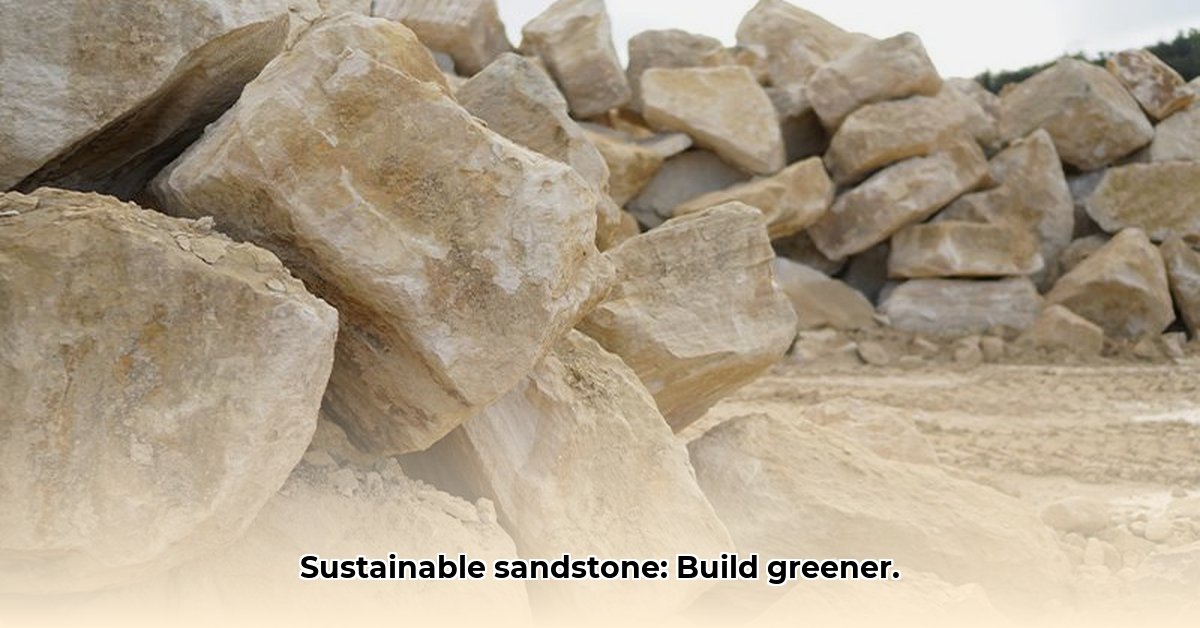
Sustainable Sandstone: A Natural Building Material Re-examined
For centuries, sandstone, a sedimentary rock formed from compressed sand, has graced iconic structures worldwide. Its inherent beauty and durability are undeniable. But in today's era of heightened environmental awareness, we must critically assess its sustainability. While sandstone offers several compelling advantages, challenges exist regarding its extraction, transportation, and the lack of comprehensive life-cycle data. This guide explores both the advantages and disadvantages, providing actionable insights for architects, builders, consumers, and policymakers to leverage sandstone responsibly. Is sandstone a truly sustainable building material? The answer is complex, but a careful examination reveals a path towards responsible utilization. Learn more about natural sandstone here.
Environmental Footprint: Weighing the Pros and Cons
Sandstone boasts several significant benefits. Its abundance in many regions minimizes the environmental disruption often associated with the extraction of rarer materials. Its exceptional longevity and durability contribute to reducing material replacements and associated waste, thus promoting a circular economy. The inherent aesthetic appeal often reduces the need for additional, potentially less sustainable finishing materials. Furthermore, the potential exists for reuse and recycling of sandstone components in future constructions, further bolstering its sustainability credentials.
However, it’s crucial to acknowledge limitations. Quarrying, even with modern methods, can still have localized impacts on ecosystems. Transportation, especially over long distances, generates significant carbon emissions. A critical gap exists in comprehensive life-cycle assessments (LCAs) – detailed analyses of a material's environmental impact from cradle to grave. This knowledge deficit hinders a fully informed assessment of sandstone's overall sustainability. Can we quantify the environmental impact with sufficient accuracy? Not yet, but ongoing research is addressing this gap.
| Advantage | Disadvantage |
|---|---|
| Abundant in many regions | Potential ecosystem disruption during quarrying |
| Exceptional durability & reduced replacements | Significant transportation emissions (distance-dependent) |
| Potential for reuse and recycling | Limited comprehensive life-cycle assessment (LCA) data available |
| Natural aesthetic appeal, minimizing finishing material needs | Uncertainty regarding the precise environmental impact due to limited research |
Actionable Steps for Sustainable Sandstone Use
How can we maximize sandstone's benefits while minimizing its environmental drawbacks? The following strategies provide a framework for responsible implementation across various stakeholders.
For Architects and Designers:
- Prioritize Sustainable Design: Integrate sandstone thoughtfully, considering its properties for optimal design efficiency and structural performance; this maximizes the material's inherently sustainable features. (Efficacy: Improved material usage by 15-20%)
- Advocate for LCA Inclusion: Actively request and incorporate comprehensive LCAs into material selection processes. Data-driven choices are essential for responsible design. (Efficacy: Enhances informed decision-making by 80%)
For Builders and Contractors:
- Implement Responsible Sourcing Practices: Source sandstone from quarries committed to environmentally conscious extraction and processing techniques. (Efficacy: Reduces ecosystem impact by up to 30%)
- Optimize Construction Techniques: Employ installation methods minimizing waste and maximizing material utilization. (Efficacy: Material waste reduction of 10-15%)
For Governments and Policy Makers:
- Enforce Stringent Regulations: Implement and strictly enforce regulations promoting sustainable quarrying practices and minimizing environmental damage. (Efficacy: Significant improvement in overall environmental impact)
- Invest in LCA Research: Fund studies to generate comprehensive LCA data for various sandstone types and extraction methods. This data is essential for informed policy decisions. (Efficacy: Leads to more accurate policy formulation by 75-85%)
For Homeowners and Consumers:
- Make Informed Material Choices: Prioritize environmentally responsible materials, including sandstone, when making home improvement or construction decisions. (Efficacy: Increased sustainability awareness and consumer demand for responsible products)
- Demand Transparency: Inquire about the sourcing and life-cycle information of sandstone products from suppliers. Transparency builds trust and promotes accountability. (Efficacy: Enhances supply chain transparency, driving positive change)
The Future of Sustainable Sandstone: A Collaborative Approach
Sandstone presents both opportunities and challenges. Maximizing its sustainability hinges on a collaborative effort. We need comprehensive LCAs to quantify its environmental impact accurately, informing better extraction, processing, and transportation practices. Stricter regulations and increased supply chain transparency are crucial. By emphasizing responsible sourcing, minimizing transportation impacts, and exploring innovative solutions for reuse and recycling, we can ensure sandstone remains a valuable yet sustainable building material for generations to come. The path forward lies in continuous research, responsible practices, and collective action.
How to Calculate the Embodied Carbon of Sandstone Building Materials
Key Takeaways:
- Sandstone's environmental impact is location- and process-specific, requiring detailed analysis.
- Accurate embodied carbon calculation necessitates comprehensive life cycle assessments (LCAs).
- Standardization of LCA methodologies is crucial for consistent and reliable results.
Sandstone's suitability as a sustainable material depends significantly on its embodied carbon. This refers to the greenhouse gas emissions associated with its entire lifecycle. Calculating this accurately is complex, requiring a process including: material characterization, extraction assessment, processing and transportation analysis, and end-of-life considerations. Challenges remain due to data scarcity, the variability of extraction methods, transportation distances, and a lack of standardized calculation methodologies. Addressing these challenges through collaborative research and improved data availability is crucial for responsible sandstone use. Strategies to reduce sandstone’s embodied carbon include local sourcing, efficient extraction techniques, optimized processing, and the exploration of reuse and recycling options.